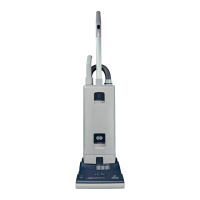8
The attachment tube (15) is useful for vacuuming corners and hard-to-reach
areas. The handle grip (1) should be in the upright, locked position (as shown in
figure 4). Grip the attachment tube handle (11), pull it up and away from the
machine and stretch out the hose (12) until it locks to the back of the tube (this
locking action will prevent the hose from retracting back into the attachment tube
while it is in use). Various attachments may be inserted onto the end of the tube.
A
fter use, remove attachment and re-insert the attachment tube into the back of
the machine. Be sure that the attachment tube handle (11) is inserted over the
projection tab (see #23, page 6). If the attachment tube handle is properly seat-
ed over the projection tab, the hose will automatically retract and you may resume
vacuuming. There is no need to turn off the vacuum while switching from upright
vacuuming to using the attachment tube or hose.
To use the hose without the attachment tube (as shown in figure 5), pull the hose out
of the attachment tube while the tube is still attached to the machine and securely
seated over the projection tab (23). Insert an attachment tool, if desired, onto the
end of the flexible hose. You may also release the hose while the attachment tube is
disengaged from the machine by pressing the release button (27) at the base of the
handle (11).
While using attachment tools, you may keep the brush roller off the carpet by
placing the handle (1) in its upright locked position and lowering the handle with
one hand to raise the brush roller off of the floor. Operate attachment accessories
with the other hand. Or, with the handle in the upright locked position, the
machine may be tipped backward so that it rests on the back side of the bag hous-
ing (6), and the power head is locked in a perpendicular position to the floor.
Ensure that no children or pets can come into contact with the spinning brush
roller.
To vacuum walls, under beds, or higher-reach areas, etc., the SEBO ESSENTIAL G
can be fitted with an additional straight tube (45) and the wall and floor brush (41).
The machine will then perform as a canister vacuum (as shown in figure 6).
The pile adjustment wheel (18) has 4 brush height settings. Setting 1 is the lowest
brush setting and setting 4 is the highest brush setting. When starting the vacuum,
always start with the knob set at 4, then lower knob settings until the brush reach-
es the proper height. The red brush light on the display panel will light after 6 sec-
onds if the brush is too high. Adjust the knob down. If after 6 seconds, the brush light
stays unlit, the brush is at the proper setting for the pile. The red brush light will
also illuminate if the setting is too low. Adjust the knob up until the light stays unlit
after 6 seconds.
The Height Adjustment Wheel - Figure 8
Red light (A): Off – Operation of machine is normal
Red light (A): Continuous – change bag or clear clog in the hose or power
head.
Red light (A): Flashing and motor off – dust bag is full, or clog in the hose or
power head due to ignoring the continuous red warning light for
full bag or clog (see above)
Red light (B): Off – Operation of brush is normal
Red light (B): Flashing while in position 1 on the pile adjustment knob (18) –
brush is worn - change brush roller
Red light (B): Continuous while in positions 1-4 – incorrect brush setting-
adjust the brush by turning the pile adjustment knob (18) to a
higher or lower position
Red light (B): Flashing and motor switched off – clogged brush
Red light (B): Flashing and motor switched off with no blockage – raise brush
to a higher position
For additional information on the display panel, see page 4
The Display Panel - Figure 7
Figure 4
Figure 5
Figure 6
Figure 7
Figure 8
45
41
1
11
15
12
6
18
Using the Attachment Tube, Hose & Attachments -
Figures 4, 5 & 6
B
A
A – Bag full or clog indicator
B – Brush clog or incorrect pile
setting monitor
27

